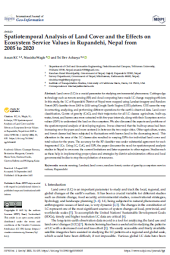Spatiotemporal Analysis of Land Cover and the Effects on Ecosystem Service Values in Rupandehi, Nepal from 2005 to 2020
Summary
This study employs the Random Forest (RF) algorithm to classify the land cover (LC) of the Rupandehi District into five main categories using spectral data from Landsat Sensor. The primary objectives include:
(1) investigating spatiotemporal changes in the district between 2005 and 2020,
(2) analyzing the Center of Gravity (CoG) trajectory for land cover classes,
(3) calculating and evaluating the Ecological Sensitivity Value (ESV) for both individual LC classes and the entire district, and
(4) addressing challenges and perspectives in the spatiotemporal analysis of developing regions.
Notably, this is the first study to utilize Google Earth Engine (GEE), CoG, and ESV for such analysis in the study area. The workflow presented here can potentially be adapted for similar assessments in other locations to quantify land changes and assess their socioeconomic implications.
Categories:
Research Paper
Writer:
Aman KC, Nimisha Wagle and Tri Dev Acharya
Link Source:
https://doi.org/10.3390/ijgi10100635
Publisher:
International Journal of Geo-Information
Published Year:
2021
